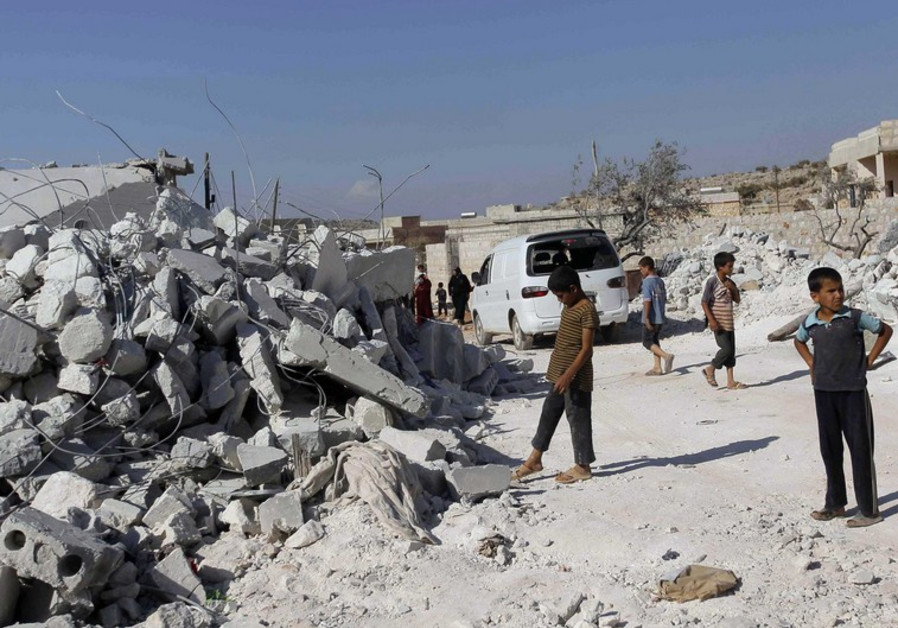BY SETH J. FRANTZMAN
Anighttime raid. Helicopters. Special forces. A high-value terrorist target. Concerns about identifying him. All this would have been on the list of challenges facing the Bin Laden raid planners in 2011. On Sunday morning, it was another group of Americans hunting ISIS leader Abu Bakr Al-Baghdadi, which had to go through the same complex set of obstacles to kill the bearded extremist hiding out in Idlib province near the Turkish border.
The raid began just after midnight when locals in towns near Barisha, just a few kilometers from the Turkish border, reported hearing helicopters. Drones were already in the air from just before midnight. Newsweek says that US President Donald Trump had approved the strike nearly a week ago. Members of the 1st Special Forces Operational Detachment-Delta – the Delta Force – were brought in to take down the target. Observers at night are not that great at determining how many helicopters are landing next to them, but locals said that they heard as many as six “chasing” a convoy of vehicles. Two of the choppers landed.
A confrontation took place. There were exchanges of gun fire. An explosion was seen. This might have gone on for around an hour. There were air strikes by several missiles. Later, drones circled overhead. Or maybe what happened was that helicopters were heard over Turkey crossing into Syria. Someone fired at the helicopters. Locals didn’t know if it was a Turkish raid or the US-led anti-ISIS coalition. Two helicopters landed out of the 12 that some said were involved. Or maybe it was eight helicopters, others said. Planes carried out air strikes.
For several hours, activity continued. Gunfire and then just the sound of drones buzzing around. Trump tweeted at 3:23 a.m. that “something very big just happened.” By morning, people had made videos of the area showing some churned up earth from an air strike. Others found evidence of a house or “compound” that might have been the target. It wasn’t that nice a villa, certainly worse than Bin Laden’s.
By seven in the morning, Syrians had passed details to Iranian officials. Iraqis were informed by 7:30 a.m. According to reports passed to Newsweek and others, Baghdadi was not the only target of the raid; he was with two wives. Baghdadi detonated a “suicide vest” or belt; they all died. According to James LaPorta at Newsweek, the US only informed Turkey after the raid had started.
WHY WAS Baghdadi in Syria, and in Idlib of all places? In September, he released a new tape, and in April he appeared on video for the first time in years. Baghdadi rose to fame in 2014, proclaiming himself “caliph” of ISIS in Mosul and leading his group to commit genocide and mass rape of minorities. But after that, he was elusive. When ISIS was mostly defeated this March, there were rumors that he was dead or injured. Then he popped up on the videos. But where was he? Supposedly he had been hiding out in desert areas of Iraq or Syria, where some 14,000 ISIS members are suspected to be. He is from Iraq so he knows how to hide out.
If he went to Idlib, why did he go? Was it a Bin Laden-type of thing, the way the Al-Qaeda leader went to Pakistan to relax after 9/11? ISIS received many recruits via Turkey and also one had more of a presence in Idlib. There are a plethora of other extremist groups in Idlib, particularly Hayat Tahrir al-Sham, which was once Al-Qaeda in Syria. Was that why he went – because these groups would act as a buffer around him? Or was he recently moved there, for various reasons, as some ISIS members migrated to Idlib after defeat in the Euphrates Valley?
And what was this “convoy” that was targeted by the helicopters? What has happened to Baghdadi’s body or what's left of it? What did Turkey know? The last question is more interesting because if Trump knew about the operation for nearly a week, that means that when US Secretary of State Mike Pompeo and Vice President Mike Pence went to Turkey on October 17, they might have learned about this from Turkey.
Could it be that there was a decision to share intelligence with Washington as part of showing the US that Turkey cared about fighting ISIS, and to soften American anger over Turkey’s invasion of Syria on October 9? Why would Baghdadi suddenly turn up in the midst of this crisis, when ISIS seemed to be on the cusp of a new lease on life after the US announced it would withdraw from parts of Syria?
Pompeo had already indicated last week that the US had fulfilled its mission in Syria. That mission was to defeat ISIS. America was supposed to withdraw fully on October 13, except from the base of Tanf near Jordan. Then Trump said that the US would stay in Syria to protect the oil. US vehicles went back to Syria on October 26. If Trump knew of the raid for days – including when he congratulated the Syrian Democratic Forces commander General Mazlum on keeping the ceasefire that the US and Russia both brokered with Turkey – what was the context of that phone call around October 21? Did Trump's anti-ISIS envoy James Jeffrey, who spoke to the Senate on October 22 about Syria, know of the upcoming raid? Or was everyone in the dark? How could US helicopters operate so close to Turkey’s border and not trigger Turkish air defense, unless Turkey was in the loop? Did the helicopters fly from Incirlik or from another base?
With so many questions about the raid, this could be Trump’s Bin Laden moment. But it could also lead to questions about America's withdrawal from Syria and its erratic policies over the last few weeks.

No comments:
Post a Comment